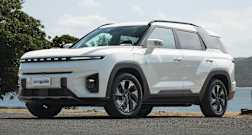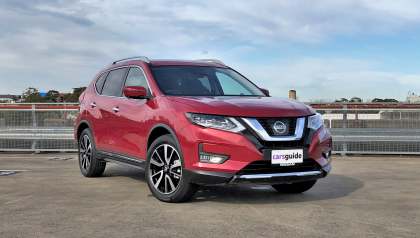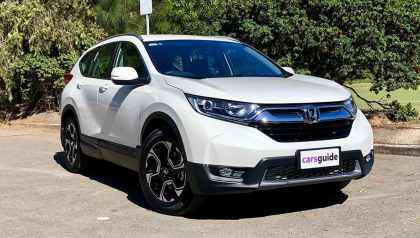Mitsubishi is a brand that makes things work.
A look at its range reveals hardly anything in the way of new product, yet continuous gradual improvement of hot-sellers like the ASX, Triton, and the Outlander we have here, have kept them front of mind for buyers year after year.
Are those gradual facelifts, price adjustments, and improvements really keeping Mitsubishi competitive though, or is it just the rush of having any new car in the right segment that’s keeping buyers enamoured?
To find out, we took the (now seven-year old) Outlander seven-seat mid-sizer for a weekly test.
Mitsubishi Outlander 2020: Ls 7 Seat (2Wd)
| Engine Type | Inline 4, 2.4L |
|---|---|
| Fuel Type | Unleaded Petrol |
| Fuel Efficiency | 7.2L/100km (combined) |
| Seating | 7 |
| Price From | $21,560 - $27,280 |
| Safety Rating |
|
Does it represent good value for the price? What features does it come with?
8 / 10
One thing that puts customers in Mitsubishis is consistently competitive pricing. Our mid-spec Outlander LS for example, comes with an MSRP of $34,290 – already cheap, but Mitsubishi will almost always have some kind of deal going.
At the time of writing they were offering this car with seven years of warranty and two years of free servicing wearing a drive-away price of $34,790. Wow.
The closest competitor for this spec Outlander is the entry-level CR-V seven-seater, the VTi-E7 ($34,490). It’s a good-looking car, and has a great high-tech engine, but misses out on some of the spec the Mitsubishi gets.
Other opponents include the Nissan X-Trail ST seven-seater ($33,090) and the flashy but expensive, diesel-only Mazda CX-8 ($42,490).
.jpg)
Okay, so it’s pretty decent value, but what spec does it offer? Surprisingly, through the years of gradual upgrades, the answer is quite a lot.
Specifically, 18-inch alloy wheels, and a new 8.0-inch multimedia touchscreen which now features Apple CarPlay, Android Auto, and DAB digital radio, keyless entry and push-start, halogen headlights with LED DRLs, rear parking sensors and reversing camera, an auto-dimming rear vision mirror, rain-sensing wipers, and auto-folding heated wing mirrors.
While sat-nav and LED headlights would be welcome, that’s a pretty decent spec considering you also get a 2.4-litre engine and seven seats as part of this car’s spec. The Honda CR-V gives it a run for its money in this department, with a very similar equipment list, but simply can’t compete when it comes to safety tech which we’ll explore later.
It’s worth noting you can also have this Outlander as a diesel all-wheel drive, but it’ll cost you at well over $40k.
.jpg)
Is there anything interesting about its design?
6 / 10
The Outlander is a tin can on wheels. That’s about all there is to it.
It’s vaguely box-shaped, more like a wagon than the kind of oval shape most SUVs are, and has styling points that are echoed throughout the rest of the brand’s “dynamic shield” range.
Admittedly, I appreciated the design that’s been poured into the rear three quarter, which manages to have just a faint smidge of sportiness about all its angles, like the little roof spoiler, slick LED rear light fittings, and chrome accent across the back.
There are some generic two-tone alloys and… well, I’m not sure what else I can say about it. Honda’s CR-V, definitely the CX-8, and I’d argue even the Nissan X-Trail offer a little extra on the exterior design front. For a more wagon-like wagon, the Subaru Forester owns it.
.jpg)
Inside is not much better. Mitsubishi’s interior design has moved at a glacial pace for the last decade.
The Outlander has the same tired old Mitsubishi steering wheel and dial cluster, the same dash design and centre console that it launched with all those years ago, but thankfully a new screen.
This 8.0-inch screen is a real strong point. The user interface isn’t pretty, but it's quick, bright and simply functional. Apple CarPlay connectivity worked a cinch for me.
As much as I criticize the dated look of this design (and its so-so plastics) I can’t say it’s not functional. Everything in the Outlander works and makes sense, so at least it’s not flawed.
.jpg)
Appreciated is the dials for controlling the air-con, but volume is adjusted through touch panels. Annoying.
The seats look simple with a faux-leather, faux-suede, dual-trim design, but they proved to be surprisingly comfortable over the course of my test week.
How practical is the space inside?
8 / 10
Plain design aside, the practicality of this Mitsubishi is great. There’s hard wearing materials everywhere, so you don’t have to worry about kids or adults destroying things, and there’s an abundance of decently sized storage areas for large bottles in the doors and consoles.
Little trenches are strewn about in the doors and transmission tunnel for keys and wallets, and the centre console box is nice and deep.
Adjustability for the driver is okay, although you do sit very high in the Outlander. It’s about as far from a ‘sporty’ seating position as you can get, but visibility is truly excellent. The Outlander’s wagon body is like a big glasshouse leading to great angles all round. The mirrors are nice and big, too, for seeing around its long body.
.jpg)
Despite that high seating position, there’s loads of airspace in the cabin. Headroom isn’t even a question for the front two rows, and neither is space for your arms.
Thanks to that long body, legroom is stellar for second-row occupants, and the seats are on rails so they can be moved further back when the third row is not in use. Doing so leads to limousine-levels of legroom. There are air vents on the back of the centre console and a lone 12-volt power outlet.
The third row is a different story. I was surprised by the amount of legroom available, but this space is absolutely not for adult passengers. I’m not super tall, at 182cm and my head is tilted a good 20 – 30 degrees to even fit in the crawlspace that is the rear row. It’ll be fine for a short-distance emergency trip, but the third row is truly meant for children.
.jpg)
Boot space is pretty good with the third row folded away. You can make use of 477 litres which is about half-way up in the mid-size SUV segment. That sounds average considering the Outlander’s shape and size, but remember that’s with two seats, a full-size alloy spare wheel, and a 63-litre fuel tank under the floor.
With the third row up, the boot is just 123 litres. Enough for a single briefcase maybe… The boot also features an extra 12-volt power outlet, cupholders for third row passengers and a false floor for stowing the retractable luggage cover.
.jpg)
What are the key stats for the engine and transmission?
7 / 10
Our Outlander was the petrol front-wheel drive version, which has a 2.4-litre non-turbo petrol four-cylinder engine.
It provides 124kW/220Nm which is easily matched by smaller capacity turbo engines (like the CR-V’s 140kW/240Nm 1.5-litre turbo).
.jpg)
The X-Trail has a similar engine with similar outputs (126kW/226Nm) and the CX-8 is diesel only.
The only transmission available with the petrol engine is a continuously variable (CVT) automatic, and all-wheel drive is optional. A 2.2-litre diesel (110kW/360Nm) with a six-speed traditional auto is available at a significant price jump.
How much fuel does it consume?
7 / 10
The Outlander is rated to consume 7.2L/100km according to its claimed/combined figure. Against that I managed to score 9.2L/100km, which is actually not bad. Given how free-revving its relatively large capacity engine is, I had expected over 10.0L/100km.
Another bonus is that it drinks base grade 91RON unleaded petrol. The Outlander has a 63-litre tank.
What's it like to drive?
7 / 10
Again, the Outlander exceeds at doing exactly what’s written on the tin, no more, no less.
For those not fussed about driving dynamics, this is actually great news. This is because the Outlander is easy to drive, and comfortable, too.
The steering is nice and light, making maneuvering easy, and the suspension has loads of travel and a forgiving tune. Perfect for families.
The large-ish engine is remarkably responsive. From zero there’s loads of torque available making zipping around a breeze. The issue is that power seems weak in the mid-range, the engine generating lots of noise for little output in the middle of the rev range.
.jpg)
The CVT is far from ‘enjoyable’ simply trundling along with its signature rubbery feedback. This reminded me a lot of the Subaru Forester which has similar performance.
Buyers looking for an Outlander probably don’t need all-wheel drive and honestly it makes little difference for those who will be sticking to the made road.
Overall, the Outlander makes for an effortless, if a little boring drive experience. It seems to be tuned exclusively for the ease of use and comfort of families, which is what the rest of it is good at anyway.
Warranty & Safety Rating
What safety equipment is fitted? What safety rating?
8 / 10
Despite launching well before any of these were a necessity, the Outlander has been rather successfully augmented with a suite of active safety items that keeps it well and truly in the game.
These up-to-date safety items include auto emergency braking (AEB – with pedestrian detection), lane departure warning (LDW), adaptive cruise control and high beam assist.
Blind spot monitoring (BSM) and lane keep assist (LKAS) would be nice but aren’t featured on the LS.
Expected refinements include six airbags, stability and brake controls, as well as two ISOFIX and three top-tether child seat mounting points on the middle row.
Hill start assist, an electronic park brake and full-size spare are welcome bonuses.
All variants of the Outlander carry maximum five-star ANCAP safety ratings as of 2014.
What does it cost to own? What warranty is offered?
7 / 10
Mitsubishi covers the Outlander with a competitive five-year warranty, but with just 100,000km of distance included, unlike most competitors' unlimited mileage.
.jpg)
As mentioned earlier, Mitsubishi often offers promotional extended warranty terms - usually seven years. Make sure you check Mitsubishi’s site to see what’s on offer if you’re considering an Outlander.
Capped price servicing does not match the warranty, with fixed prices only lasting for three years. The price is low at just $199 per yearly, 15,000km visit. Again, free servicing for a certain number of years is frequently a promotional offer.
Verdict
Mitsubishi’s Outlander is not an exciting SUV to drive or look at. Instead it’s predictable, comfortable and a bit of a swiss army knife for families.
You can’t argue with its value offering, either, and the improved safety and multimedia offering keeps it in the fight against more recently launched rivals.
Makes sense then, that Mitsubishi has no trouble moving tons of them.
Pricing Guides







.jpg)





.png)




_0.jpg)